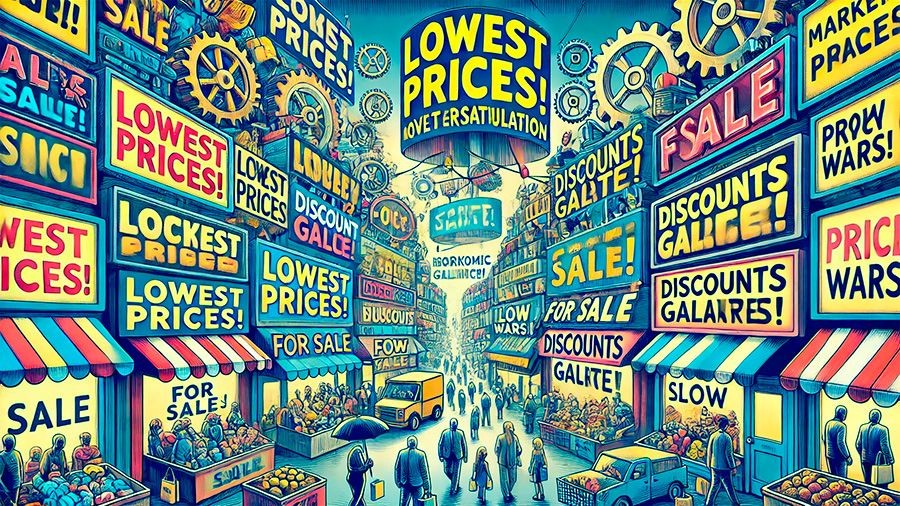
As the global economy becomes increasingly service-oriented, many industries are witnessing the effects of market oversaturation. The rise of technology, changes in consumer preferences, and globalization have all contributed to an oversupply of services, where demand is not sufficient to sustain all the businesses offering them. While services are the backbone of many advanced economies, an oversaturated services market can lead to several economic challenges, including price wars, reduced profitability, and market stagnation. This article examines the economic impact of an oversaturated services market from a global perspective, exploring how different nations are responding to and addressing these challenges.
The Dynamics of Market Oversaturation
Market oversaturation occurs when the supply of services exceeds the demand for them, leading to fierce competition, decreased profit margins, and the struggle for market share. This phenomenon can be observed in numerous sectors, including hospitality, retail, healthcare, finance, and education. While the influx of service providers can benefit consumers in terms of choice and lower prices, it can also result in market fragmentation, making it difficult for businesses to sustain themselves in the long run.
1. Causes of Oversaturation in Services
Several factors contribute to the oversaturation of the services market, with technological advancements and market accessibility playing major roles. As barriers to entry decrease, more businesses are able to offer similar services, leading to an oversupply. Additionally, consumers’ evolving demands for convenience, lower prices, and customized experiences have influenced the rise of service providers in many sectors.
Key drivers of services market oversaturation:
- Technological advances: Automation, digital platforms, and online services have lowered entry barriers, allowing more businesses to enter competitive sectors.
- Globalization: International competition has introduced new service providers from different parts of the world, increasing service availability and lowering costs.
- Consumer demand: Changing consumer behavior, particularly in sectors like entertainment, finance, and travel, has led to a surge in businesses offering similar services in an attempt to cater to a more diverse and demanding customer base.

The Economic Consequences of Market Oversaturation
Oversaturation in the services market has significant economic implications, both for businesses and the broader economy. While competition can drive innovation and lower costs for consumers, it can also lead to unintended consequences, including economic instability, reduced service quality, and higher levels of business failure.
1. Price Wars and Decreased Profit Margins
One of the most immediate effects of oversaturation is the onset of price wars, where businesses lower their prices in a bid to attract customers. This price competition often leads to diminished profit margins, especially for smaller companies that cannot afford to operate at lower prices. Over time, this can result in business closures and job losses, as companies are unable to maintain profitability in an overly competitive market.
Economic impact of price wars:
- Reduced profitability: As prices are slashed, businesses often find it difficult to cover their operational costs, which can lead to a decline in profitability and long-term sustainability.
- Business closures: Small and medium-sized enterprises (SMEs) are often the first to be affected by price wars and may face closure as they struggle to compete with larger firms.
- Job losses: Businesses that fail to maintain profitability may resort to layoffs, affecting workers in affected sectors and contributing to higher unemployment rates.
2. Quality Dilution and Consumer Experience
In a market flooded with service providers, businesses may begin to cut corners to maintain competitive pricing. This can lead to a decline in service quality, as companies attempt to lower costs by reducing the quality of the services they provide. For consumers, this can result in a poor experience, where the initial appeal of low prices is overshadowed by subpar offerings.
The impact on service quality:
- Cost-cutting measures: To stay competitive, businesses may reduce service standards, leading to dissatisfaction among customers and a reduction in brand loyalty.
- Overwhelmed service providers: With too many service providers competing for the same customer base, some businesses may struggle to maintain consistent quality, resulting in negative reviews and loss of reputation.
- Increased consumer confusion: Oversaturation can lead to consumer confusion, as customers may find it difficult to differentiate between providers, resulting in poor decision-making.
3. Economic Stagnation and Slow Growth
When too many businesses offer similar services, the overall market becomes fragmented, leading to slower economic growth. The lack of differentiation means that many businesses operate within the same niche, making it difficult for innovation to occur. As a result, the overall market can stagnate, preventing industries from evolving and creating fewer opportunities for long-term growth.
Economic effects of stagnation:
- Lower innovation: With a saturated market, businesses are often forced to compete on price rather than innovation, stifling creativity and progress in service delivery.
- Market fragmentation: Oversaturation leads to smaller market shares for each provider, which makes it difficult for any single business to dominate and scale effectively.
- Decreased investment: Investors may be hesitant to invest in sectors that are oversaturated, leading to a lack of capital flowing into the industry and hindering potential economic development.

Global Responses to Service Market Oversaturation
Countries and businesses around the world have recognized the challenges posed by market oversaturation and are implementing various strategies to manage and mitigate these effects. These strategies focus on fostering innovation, regulating market competition, and encouraging businesses to differentiate themselves from competitors.
1. Encouraging Innovation and Differentiation
To address oversaturation, businesses are being encouraged to innovate and differentiate their services. Innovation allows businesses to offer unique value propositions that stand out from competitors, which is essential in a crowded market. Countries can also support innovation through research and development (R&D) grants, tax incentives, and investment in emerging technologies.
How innovation can drive differentiation:
- Product and service innovation: Developing new service offerings or improving existing services can create a unique market position, allowing businesses to stand out in an oversaturated market.
- Technological advancements: The use of technology, such as automation, artificial intelligence, or data analytics, can improve operational efficiency, customer experience, and business competitiveness.
- Customization and personalization: Offering personalized services tailored to specific customer needs can create a strong competitive edge in the services sector.
2. Regulatory Measures to Manage Competition
Governments are also playing a role in managing market oversaturation through regulatory measures that prevent unfair competition and protect smaller businesses. Regulations may include antitrust laws, price controls, and guidelines for fair competition to ensure that no single player dominates the market at the expense of others. By promoting healthy competition, governments help stabilize industries and prevent market collapse.
Key regulatory measures:
- Antitrust laws: These laws prevent monopolistic practices, ensuring that businesses have a fair chance to compete and that prices remain reasonable for consumers.
- Consumer protection: Regulations that protect consumers from misleading advertising, substandard services, and unfair business practices help maintain trust in the market and ensure fairness.
- Support for small businesses: Governments may offer grants, subsidies, or tax breaks to encourage the growth of smaller service providers and prevent market domination by a few large firms.
3. Promoting Sustainable Business Practices
Encouraging sustainable business practices is another way to manage oversaturation. Sustainable businesses tend to differentiate themselves through environmentally responsible practices, ethical labor standards, and long-term growth strategies that prioritize the well-being of customers, employees, and the planet. Nations and businesses that adopt sustainability as a core value are better positioned to thrive in an oversaturated market by meeting consumer demands for corporate responsibility.
The role of sustainability in market differentiation:
- Environmental sustainability: Businesses that focus on reducing their environmental footprint through green technologies, waste reduction, and sustainable sourcing can attract eco-conscious consumers.
- Ethical practices: Companies that prioritize fair wages, ethical labor practices, and transparency build trust and loyalty with customers.
- Long-term growth strategies: Businesses that focus on sustainable growth, rather than short-term profits, are better positioned to weather economic challenges and compete in saturated markets.
Conclusion
Oversaturation in the services market poses significant challenges to businesses and economies globally. While increased competition can drive innovation and lower prices, it can also lead to reduced profitability, market fragmentation, and economic stagnation. Governments and businesses must adopt strategies that foster innovation, support smaller players, and encourage fair competition to combat the negative effects of oversaturation. By focusing on differentiation, sustainability, and regulatory measures, we can ensure that the services market remains dynamic, competitive, and capable of driving long-term economic growth.






